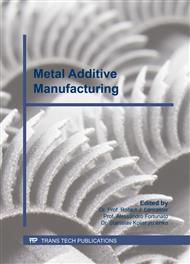p.304
p.309
p.314
p.323
p.330
p.337
p.342
p.351
p.357
Energy Absorbing Properties of the Cellular Structures with Different Wall Thickness, Produced by the Selective Laser Melting
Abstract:
Production of the honeycomb or thin walled structures by the selective laser melting of powder is of a great scientific and practical interest. It’s because that such approach allows producing structures practically of any configuration and thickness, unobtainable or very hard to produce by traditional methods. Using the additive technology, the principal difference from the traditional is that the honeycomb structures can be produced practically of any shape, and the method itself is 100% waste-free, because there is no need in supporting structures. The results of the structure investigation of the honeycomb structures with the wall thickness of 80-170 μm and 44 mm height are presented along with the correlation dependencies between samples mass, wall thickness, activation and compression loads.
Info:
Periodical:
Pages:
330-336
Citation:
Online since:
October 2018
Price:
Сopyright:
© 2018 Trans Tech Publications Ltd. All Rights Reserved
Share:
Citation:



